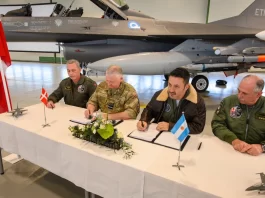The United States Air Force and Air Combat Command have acquired a brand-new E-11A Battlefield Airborne Communications Node (BACN) aircraft, which arrived at Prince Sultan Air Base, Saudi Arabia, on December 16 2022, to provide the 430th Expeditionary Electronic Communications Squadron ‘Black Wolves’ fleet with airborne combat communications support.
The 430th EECS of the United States Air Force is the only unit flying the E-11A aircraft with the BACN payload. As a result, the Black Wolves make an effort to provide uninterrupted and efficient communication channels for air, land, and sea soldiers operating within the area of responsibility of the United States Central Command (USCENTCOM).
In essence, the E-11A performs the role of a low earth satellite, sometimes known as “Wi-Fi in the sky,” to enhance the capabilities of aerial command and control for ground forces and air assets.
The E-11A is the only aircraft in the United States Air Force of its kind, and all of the pilots in the 430th EECS are volunteers who have experience flying other types of aircraft.
Since the beginning of the BACN mission in 2008, the 430th has consistently provided thousands of annual flying hours and has demonstrated that it is an essential component of modern warfighting.
In light of the E-11A’s high mission success rate in the Middle East and the strategic capability benefits the aircraft provides to the combined force, the Air Force has announced its intention to establish a new E-11A BACN squadron at Robins Air Force Base in Georgia.
At the moment, BACN operates on two different platforms: the E-11A, which is a modified Bombardier business jet, and the EQ-4B, which is a modified Global Hawk Block 20 remotely piloted aircraft.
What do we know about the E-11A BACN aircraft?
The E-11A BACN aircraft are based on the current Bombardier Global 6000 ultra-long-range business jet, with a list price of almost $60 million. BACN installation increases the cost of the aircraft. The BACN is responsible for integrating aeroplanes, drones, and ground personnel using diverse communication standards and frequencies into a single network. The aircraft facilitates interaction and coordination between the armed forces of multiple allied nations.
Only six E-11A BACN have been built. In addition, three EQ-4B communication UAVs are known to have been built and were deactivated in 2021. In 2020, one of the E-11A BACN aircraft crashed in Afghanistan. According to the Air Force’s accident report, the E-11A crash occurred on January 27, 2020, and two pilots were fatally injured. Following a catastrophic engine failure, the E-11A crashed in Ghazni Province, Afghanistan. The report stated the cost of damages to government property was $120 million, which could have referred to the aircraft cost.
The need for a flying router
The earliest US engagements in Afghanistan in 2001 and Operation Anaconda in 2002 revealed serious communication issues. The effectiveness of communication between different classes of troops was lacking. The interplay between ground forces and strike aircraft was disastrous. Worse was the situation with allied aviation coordination.
According to The Aviationist, an authoritative aviation site, F/A-18 fighters and B-52 and B-1 heavy bombers could communicate information. They were experiencing difficulties interacting with older planes, including the stealth F-22. These are just a few of the known issues.
To address the dilemma, an emergency effort was launched in 2004 to develop and instal a suite of air network equipment on a commercial aircraft base. The first prototype was shipped to Afghanistan in 2008, and the system went into operation in 2010. Since then, a fleet of four E-11As flew four to five hours per day over Afghanistan and adjacent nations. By the beginning of 2017, it was reported that they had surpassed 10,000 sorties.
Aircraft E-11A BACN became “flying routers”. Their technology enables the automatic switching of military tactical communication networks from multiple branches of the armed forces and increases the range of small drones. They can also relay messages from ground combat groups, reconnaissance, artillery, and air gunners. This is crucial in modern settings to enable the operation of multiple automated battlefield technologies and the realisation of the “network-centric warfare” concept.





